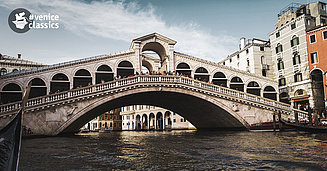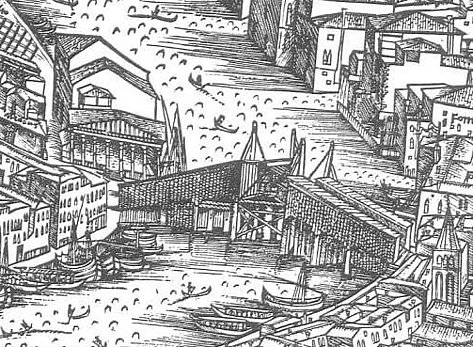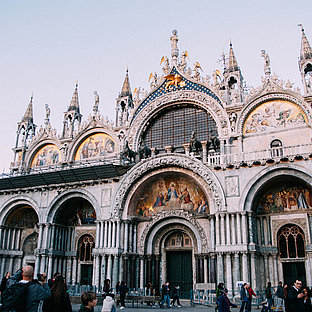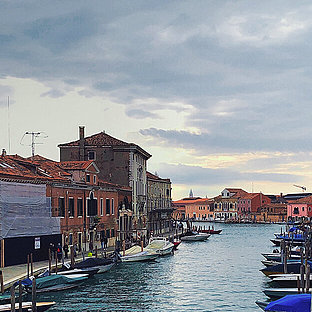Rialto Bridge: Connection between San Polo and San Marco #veniceclassics
4 min readPrevious building
Up until the 13th century, the Grand Canal in Venice was too wide for a permanent bridge and could only be crossed by ferry, and later via a ship bridge. The first permanent bridge over the Grand Canal is said to have been built in 1246 by the Doge Renier Zen. It was made entirely of wood and was already called Rialto Bridge referring to the nearby market.
Its appearance around 1500 is known quite well because it was captured on two historical works art. Interestingly, the predecessor of today's Rialto Bridge already had "botteghe" (small shops) on both sides and a footpath in between that rose to the middle of the bridge. At the highest point of the sidewalk was a drawbridge, which allowed larger ships, such as the "Bucintoro", the pompous state galley of the Doge, to pass through to the Adriatic.
After a large stone arch bridge over the Canal di Cannaregio had already been completed in 1507 with the Ponte di Tre Archi, the basic decision was made to replace the Rialto Bridge sooner or later with a stone structure.
Architecture Competitions
In the mid-16th century, the first architectural competition for the construction of a stone arch bridge over the Grand Canal was announced. Well-known architects such as Palladio and Michelangelo, who were among the best-known builders in Europe at the time, took part in this competition. But even the big names could not convince the lenders to implement their plans.
In a second competition Vicenzo Scamozzi (1548-1616, a student of Palladio) and Antonio da Ponte (1512-1595) emerged from the submitted proposals as the main opponents. Both initially proposed a three-arch solution. Da Pontes' second draft, however, proposed the one-arch solution, which was eventually awarded and realized. Construction began on February 1, 1588. Just three years later, on March 20, 1591, the new sandstone bridge was inaugurated.
Construction
The foundation of the Rialto Bridge consists of approximately 12,000 alder trunks, each 3.50 m long. You have to take into account that in the 16th century the piles were rammed into the ground exclusively with muscle power. The surface formed by the piles was covered with strong planks. Da Ponte introduced an innovation by arranging the masonry at a 90° angle.
The segmental arch of the Rialto Bridge has a span of almost 29 m and an arrow height of 6.40 m. It corresponds to a quarter circle and is therefore extremely flat, which - despite the high structures on top of it - makes it appear extremely light and elegant. Many technical details were taken over in later bridge constructions.
Trading on a bridge
For a long time, the Rialto Bridge was the only bridge over the Grand Canal. Only in 1854 the Accademia Bridge was added as a footpath across the Grand Canal. The Rialto bridge became a central place for trading in Venice. Many ships moored here and sold their goods directly on the bridge. It was even said that the city's economic heart was beating right under this bridge! Because the most luxurious goods were brought ashore via the Rialto Bridge, important trading houses and banks arose around the bridge and the most influential families lived in the palazzi near the bridge. Still today there are many shops on the bridge itself.
The Rialto Bridge today
There are three parallel walkways that are interrupted by the two rows of shops. The outer walkways are 5 m wide, while the middle aisle is a little wider at 6.50 m. For the botteghe there is only a little more than 3 m wide. Although the footprint of the shops is just over 10 m², they are very popular with the city's traders and are permanently let. No wonder, because there should not be many places in Europe that come across so many buyers who are ready to buy every day.








